The Asch Building
Occupying the top three levels of the structure is the Triangle Shirtwaist Company of Russian-born Jewish immigrants Max Blanck and Isaac Harris, the era's "Shirtwaist Kings" (the men have a history with fires ... their Triangle operation has been scorched twice in 1902, and their Diamond Waist Factory burned down twice, in 1907 and 1910, conflagrations that the men received insurance money for both times) manufacturers of the popular shirtwaist, a high-necked blouse usually made of light, crisp translucent cotton or sheer linen that had come into fashion at the end of the previous century, due in large part to it being featured on the models of "Gibson Girl" illustrator, Charles Dana Gibson. The company's profits exceeding a million dollars a year by 1908 (the blouses sell for roughly $3), Harris supervises garment production, overseeing the machinery and workflow of the employees, while Blanck is in charge of sales (though Triangle is their largest enterprise, the men also own shirtwaist facilities elsewhere in New York City, Newark, New Jersey, and Philadelphia, Pennsylvania). In 1911, the company employees roughly 600 individuals, most of them easily replaceable teenage girls just arrived in America from Russia and Italy that don't speak English and can't protest working conditions and wages ... employees work as late as to 9:00 at night during the peak season with no overtime pay or a supper break, have shifts that call for nine hour days during the week, and seven hours days on Saturday and Sunday (for which they are paid between $7 and $12 a week), although against the law, doors are kept locked to prevent keep employees from absconding with company property, workers are searched day before leaving for home to make sure they haven't stolen anything, doors at the factory swing in instead of out, there are four elevators with access to the factory floor, but only one is operational, the women aren't allowed to join the Ladies Garment Workers Union (thugs are hired to deal with strikers and political payments are made for authorities to look the other way), there are no fire alarms in the building, and though more were promised as part of the original build, the building has only one fire escape. Tragedy awaiting only a spark, the spark comes as the factory's work day is ending, at 4:40 on a Saturday afternoon.

Gibson

Shirtwaist Fashion

Max Blanck & Isaac Harris
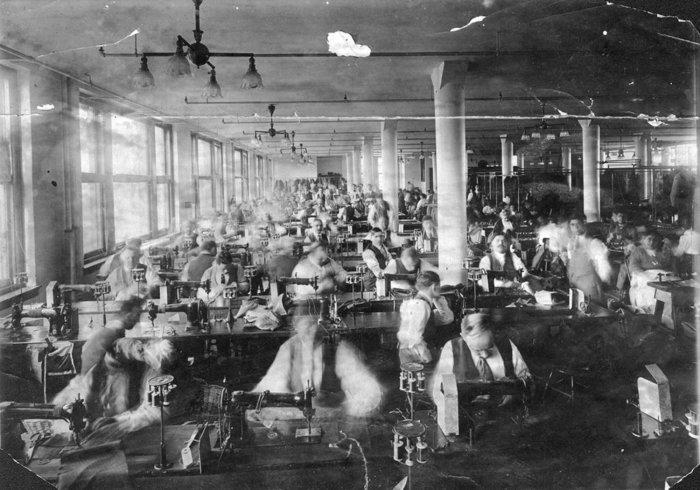
Before
Fire breaks out in a scrap bin on the 8th floor filled with two months of the factory's cuttings, hundreds of pounds of material in a wooden bin, under a wooden table, surrounded by hanging fabrics. The culprit, though smoking is banned, with no breaks, employees sneak smokes while on the floor, and someone deposited a still warm cigarette butt in the bin. Water buckets on the floor to put out just such a fire prove inadequate, and when a shipping clerk tries to put out the fire with a hose, he is horrified to discover that not only has the hose rotted, its valve has rusted shut ... the flames are soon out of control and chaos soon reigns in the building. At 4:45 the first fire alarm is given when a passerby on the street below sees smoke coming from the 8th floor. Inside, a bookkeeper on the 8th floor, Dinah Lifschitz, calls on the telephone to warn the 10th floor of what is taking place below, information which Blanck and Harris use to immediately flee to the roof and then across to another building to safety with members of their families, two of Blanck's daughters and their governess, who are visiting the operation (thanks to Professor Frank Sommer and his law student class next door, placing ladders left by painters, across to the 10th floor of the Asch Building, in all, 69 of the 70 individuals on the 10th floor when the fire breaks out will be saved). The 8th floor, aware of the flames, escapes downward, the 10th floor goes up and over the roof, but the 9th floor suddenly finds itself in mortal danger ... the stairway down to Washington Place is locked and the supervisor with its key has already fled, withing three minutes, the Greene Street stairway becomes unusable in both directions, the single exterior fire escape collapses from the heat and overcrowding, sending 20 employees to their deaths on the street a 100 feet below, and with the two elevators giving access on to and off of the floor, both soon made non-operational by the raging flames, able to take only 12 people to safety at a time, elevator operator heroes Joseph Zito and Gaspar Mortillalo, risking their own lives, are able to rescue 150 souls (after the elevators break down, prying the doors of the elevator open, more employees plunge to their deaths in the shaft trying to climb down the elevator cables, 36 in all, and four hours later, after the holocaust has finally been put out, its last survivor will be found in the rising waters inside the shaft). And even when New York firefighters arrive on the scene their rescue efforts seem cursed; the fire department's ladders only reach six stories high, and its jump nets prove inadequate, jumpers tear straight through the netting to the cement sidewalks, or bounce out with the same result ... death for the jumper.

Layout Of The Tragedy

The Fire Escape Wreckage
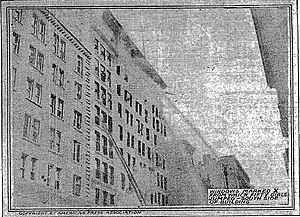
South Side Of The Building - Where 50 Jumped
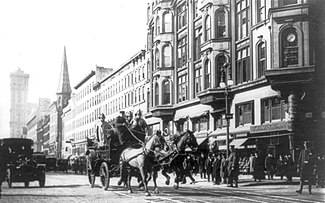
Rushing To The Fire

The Asch Building On Fire
A hell of fire and smoke, employees of the Triangle Shirtwaist Company die from fire, smoke inhalation, and the smashings they take when trying to escape the other two killers, they jump away from the flaming building to the streets below (over sixty by some estimates, often holding the hands of another jumper, some experiencing a last kiss before leaping, and many plummeting, already on fire) ... scenes of horror that fire fighters, police, and witnesses (over ten thousand will rush to the scene, including dozens of pick pockets taking advantage of the situation) will remember for the rest of their lives (a reporter will write, "I learned a new sound that day, a sound more horrible than description can picture - the thud of a speeding living body on to a stone sidewalk."). Minutes of forever, the fire is out 18 minutes after its start, taking 146 lives with it ... 123 women and 23 men, the oldest victim is 43-year-old Providenza Pannino, the youngest victims are 14-year-olds Kate Leone and Rosario Maltese. Corpses removed, the dead are brought to Charities Pier on 26th Street (also called "Misery Lane") where they are placed in simple wooden coffins for identification by their families prior to internment in a host of local cemeteries (six, unidentified at first, will be buried in Brooklyn's Cemetery of the Evergreens ... over 100 years later, it will take historian, Michael Hirsch, four long years of research to eventually identify them by name).
Carnage
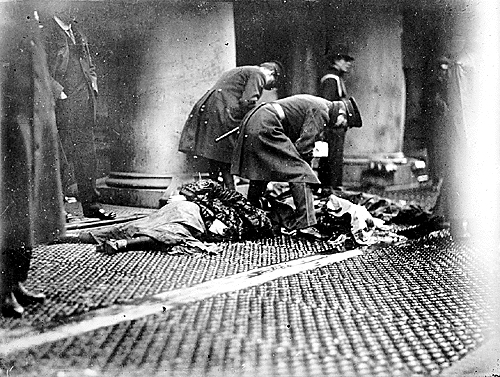
Victims
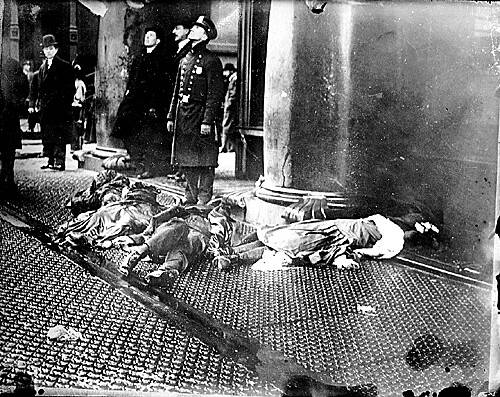
On The Street Below
/https://public-media.si-cdn.com/filer/c6/97/c697b065-e0bd-4970-81ea-819779296b91/u765404inp.jpg)
Inside - After
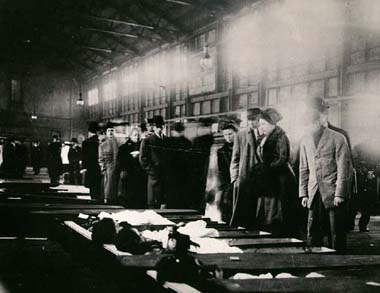
At The Pier
Deaths not in vain, in the aftermath of the tragedy, over 80,000 people will march on 4/5 through the streets of New York City in protest of the working conditions the women faced, and in October, the state will pass the Sullivan-Hoey Fire Prevention Law (between 1911 and 1914, thirty-six new labor laws will be enacted to protect workers), also in October, the American Society of Safety Professionals is created, and a nine-member Factory Investigating Committee is created to investigate safety and working conditions in New York factories. And of course, given the circumstances, Blanck and Harris go on trial for the deaths of their 146 employees. Indicted two weeks after the fire on charges of first and second degree manslaughter, the pair are prosecuted by Assistant District Attorney Charles S. Bostwick, and defended by famous New York attorney, Max David Steuer. Trial beginning on December 4, 1911, in the courtroom of Judge Thomas Crain, Bostwick presents 103 witnesses, while Steuer puts up 52. It all takes two weeks ... on 12/27 the judge charges the jury using the test of Article 6, Section 80 of New York's Labor Law ... and only two hours later, both men are incredibly found not guilty, jurors deeming there was no hard evidence that the pair "knew" the stairwell to safety from floor #9 was locked (Bostwick will go after the men again in 1912, but Judge Samuel Seabury will throw out the case, deeming it constitutes double-jeopardy over a matter already tried) ... escorted by five police officers, the pair flee the upset citizens of New York (screaming "Justice. Where is Justice?") through the judge's chamber and private entrance, barely beating a mob to the nearby subway station. In civil suits over the matter, in 1913 plaintiffs in twenty-three individual cases are awarded an average of $75 for each life lost (while Blanck and Harris receive a payout of $60,000 from their insurance company).
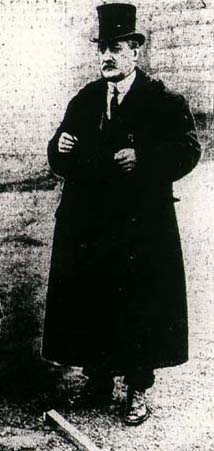
Bostwick
Steuer

Listening To Testimony .
Over a century ago, the fire has had its tale told in films and on television, with music, theatre, and dance, and in literature. The Asch Building still exists in New York City, but it is now called the Brown Building and is part of the campus of New York University (it is deemed a National Historical Landmark in 1991 and is designated a New York City landmark in 2003). The last living survivor of the fire, Rose Freedman, dies in her Beverly Hills home in February of 2001 at the age of 107.
Rose
Rose

Headlines
If you had money you could get away with almost anything in those days.
ReplyDelete